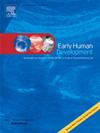Exploring congenital hypertrophic pyloric stenosis in preterm and low weight infants: A Western China perspective
IF 2.2
3区 医学
Q2 OBSTETRICS & GYNECOLOGY
引用次数: 0
Abstract
Purpose
To retrospectively analyze the clinical characteristics of congenital hypertrophic pyloric stenosis (CHPS) patients with different gestational ages and admission weights.
Materials and methods
The clinical records of CHPS patients between 2008 and 2022 were retrospectively reviewed. The patients were classified into two main groups: premature group and full-term group. Moreover, they were further divided into two subgroups based on their admission weight, namely the ≤3 kg group and the >3 kg group.
Results
The median age at the onset of the disease for premature infants was found to be later than that for full-term infants, with values of 29.00 days and 22.00 days respectively (P = 0.015). In terms of the proportion of patients with dehydration, it was significantly higher in the premature infants group compared to the full-term infants group, reaching 45.83 % and 25.30 % respectively (P = 0.026). Regarding the median pyloric muscle thickness, it was 0.45 (0.43–0.515) cm in the weight ≤3 kg group and 0.48 (0.43-0.53) cm in the weight >3 kg group, with a significant difference (P = 0.028).
Conclusion
There are distinct differences in the clinical characteristics of CHPS patients with different gestational ages at birth and admission weights. Premature infants show a later onset age and a higher proportion of dehydration. Additionally, the pyloric muscle thickness is also related to the admission weight of infants.
探讨先天性肥厚性幽门狭窄在早产儿和低体重儿:中国西部的视角
目的回顾性分析不同胎龄和入院体重的先天性肥厚性幽门狭窄(CHPS)患者的临床特点。材料与方法回顾性分析2008 ~ 2022年CHPS患者的临床资料。将患者分为两组:早产儿组和足月组。并根据入院体重进一步分为≤3kg组和>; 3kg组。结果早产儿发病年龄中位数晚于足月儿,分别为29.00 d和22.00 d (P = 0.015)。在脱水患者比例方面,早产儿组明显高于足月儿组,分别达到45.83%和25.30% (P = 0.026)。幽门正中肌厚度,体重≤3 kg组为0.45 (0.43-0.515)cm,体重≤3 kg组为0.48 (0.43-0.53)cm,差异有统计学意义(P = 0.028)。结论不同胎龄和出生体重的CHPS患者临床特征有明显差异。早产儿发病年龄较晚,脱水比例较高。此外,幽门肌厚度也与新生儿入院体重有关。
本文章由计算机程序翻译,如有差异,请以英文原文为准。
求助全文
约1分钟内获得全文
求助全文
来源期刊

Early human development
医学-妇产科学
CiteScore
4.40
自引率
4.00%
发文量
100
审稿时长
46 days
期刊介绍:
Established as an authoritative, highly cited voice on early human development, Early Human Development provides a unique opportunity for researchers and clinicians to bridge the communication gap between disciplines. Creating a forum for the productive exchange of ideas concerning early human growth and development, the journal publishes original research and clinical papers with particular emphasis on the continuum between fetal life and the perinatal period; aspects of postnatal growth influenced by early events; and the safeguarding of the quality of human survival.
The first comprehensive and interdisciplinary journal in this area of growing importance, Early Human Development offers pertinent contributions to the following subject areas:
Fetology; perinatology; pediatrics; growth and development; obstetrics; reproduction and fertility; epidemiology; behavioural sciences; nutrition and metabolism; teratology; neurology; brain biology; developmental psychology and screening.
 求助内容:
求助内容: 应助结果提醒方式:
应助结果提醒方式:


